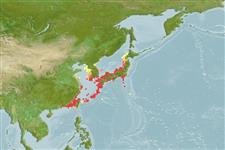>
Gobiiformes (Gobies) >
Gobiidae (Gobies) > Gobionellinae
Etymology: Rhinogobius: Greek, rhinos = nose + Latin, gobius = gudgeon (Ref. 45335).
Issue
This species is synonym of Rhinogobius similis Gill, 1859 according to Suzuki et al., 2015 (Ref. 104791). The species page will be removed.
Environment: milieu / climate zone / depth range / distribution range
Ökologie
seewasser; süßwasser; brackwasser demersal; amphidrom (Ref. 51243). Subtropical; 45°N - 22°N
Asia: China, Korean Peninsula, Taiwan, and Japan (Ref. 559) and Viet Nam (Ref. 44416).
Length at first maturity / Size / Gewicht / Alter
Maturity: Lm 4.7 range ? - ? cm
Max length : 12.1 cm TL Männchen/unbestimmt; (Ref. 114983); common length : 7.5 cm SL Männchen/unbestimmt; (Ref. 35840); max. veröff. Gewicht: 14.90 g (Ref. 114983)
Rückenflossenstacheln (insgesamt): 7; Rückenflossenweichstrahlen (insgesamt): 8; Afterflossenstacheln 1; Afterflossenweichstrahlen: 8
Found both upstream and in estuaries. Carnivorous. Spawning season from July to October. Eggs are laid under stones in river shoals. Larvae travel in both river and the sea, and return to rivers from September to November. Caught by small trap nets in rivers, but not in abundance.
Life cycle and mating behavior
Geschlechtsreife | Fortpflanzung | Ablaichen | Eier | Fecundity | Larven
Masuda, H., K. Amaoka, C. Araga, T. Uyeno and T. Yoshino, 1984. The fishes of the Japanese Archipelago. Vol. 1. Tokai University Press, Tokyo, Japan. 437 p. (text). (Ref. 559)
IUCN Rote Liste Status (Ref. 130435)
Bedrohung für Menschen
Harmless
Nutzung durch Menschen
Fischereien: kleinfischerei
Mehr Information
ReferenzenAquakulturAquakultur ProfilZuchtlinienGenetikElectrophoresesVererbbarkeitKrankheitenVerarbeitungNutrientsMass conversion
Tools
Zusatzinformationen
Download XML
Internet Quellen
Estimates based on models
Preferred temperature (Ref.
123201): 17.2 - 26, mean 22.4 °C (based on 245 cells).
Phylogenetic diversity index (Ref.
82804): PD
50 = 0.5000 [Uniqueness, from 0.5 = low to 2.0 = high].
Bayesian length-weight: a=0.00933 (0.00739 - 0.01179), b=3.08 (3.01 - 3.15), in cm total length, based on LWR estimates for this species (Ref.
93245).
Trophic level (Ref.
69278): 3.2 ±0.43 se; based on food items.
Generation time: 1.1 ( na - na) years. Estimated as median ln(3)/K based on 1
growth studies.
Widerstandsfähigkeit (Ref.
120179): hoch, Verdopplung der Population dauert weniger als 15 Monate. (Preliminary K or Fecundity.).
Fishing Vulnerability (Ref.
59153): Low vulnerability (14 of 100).
